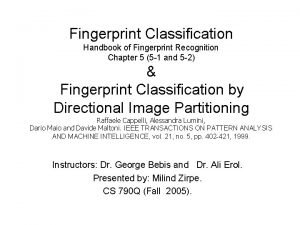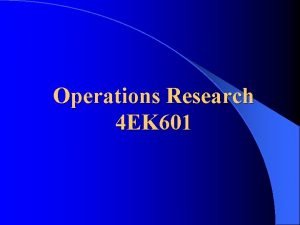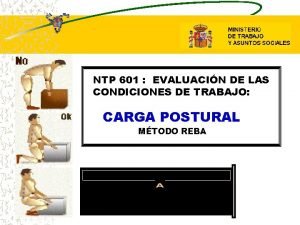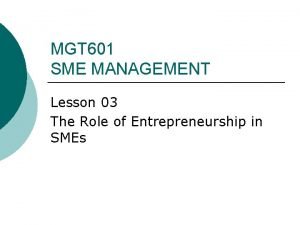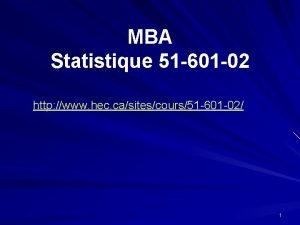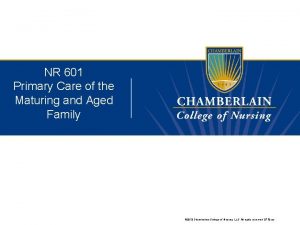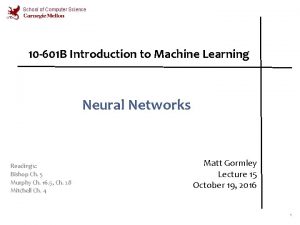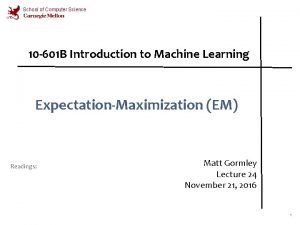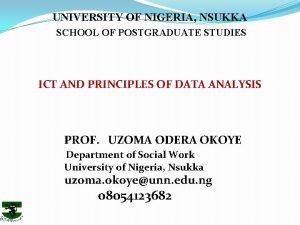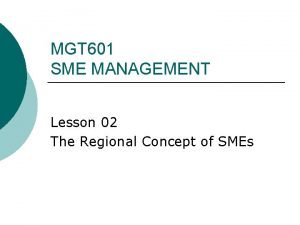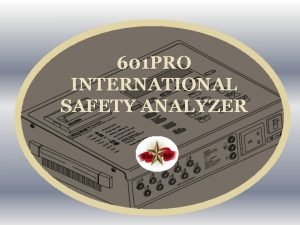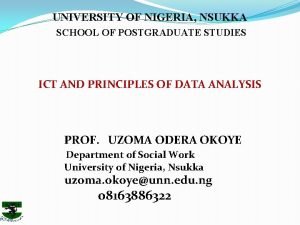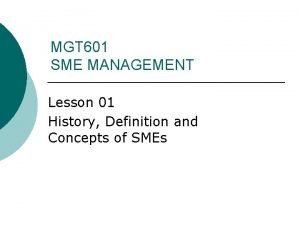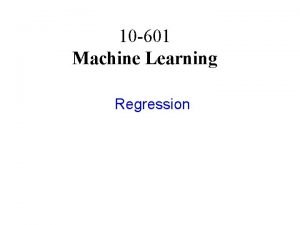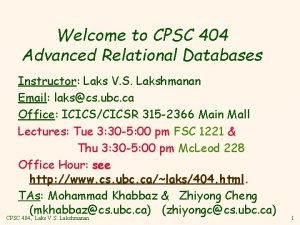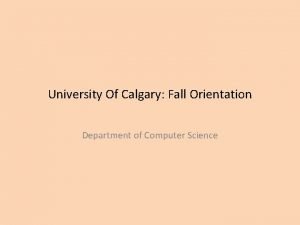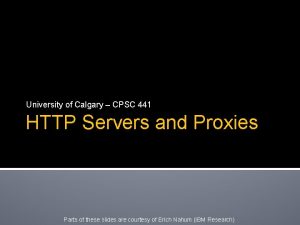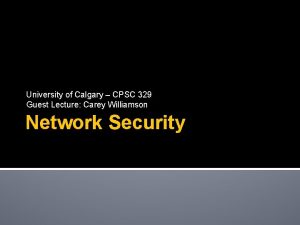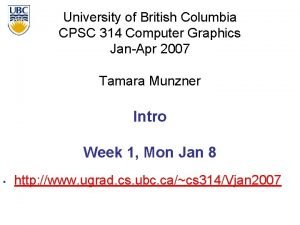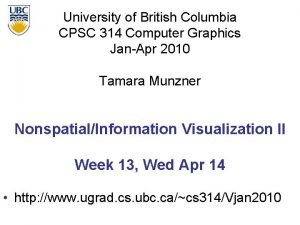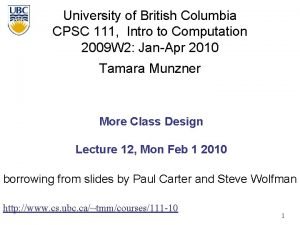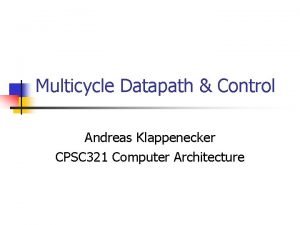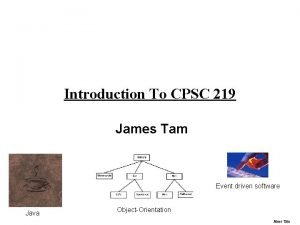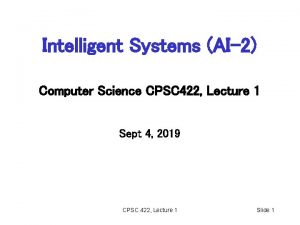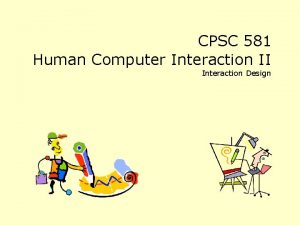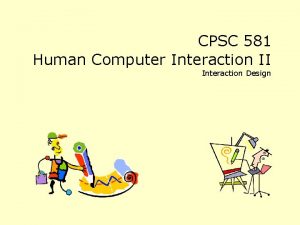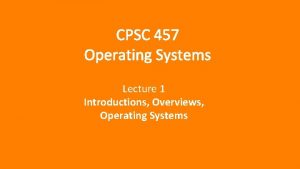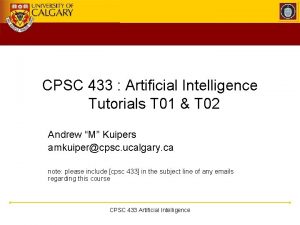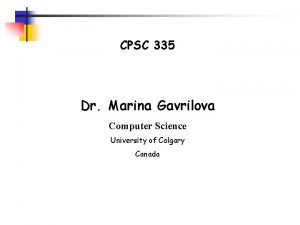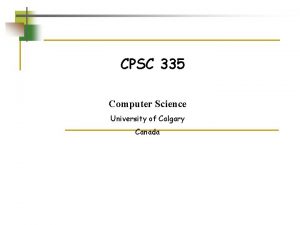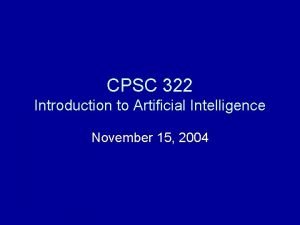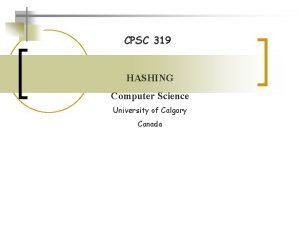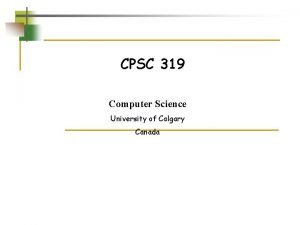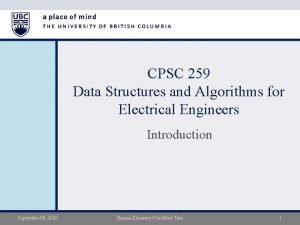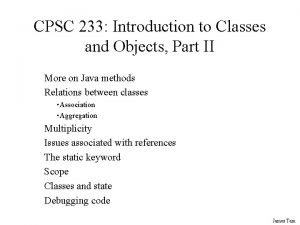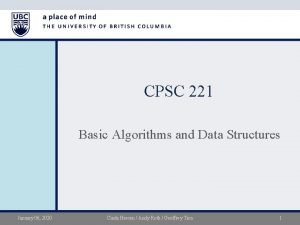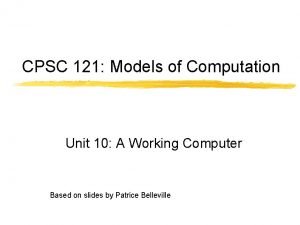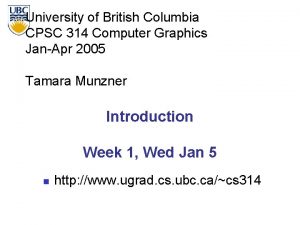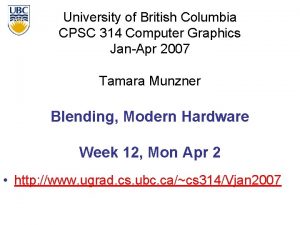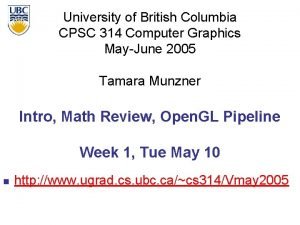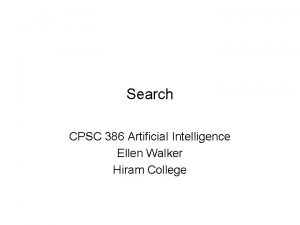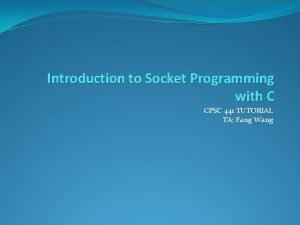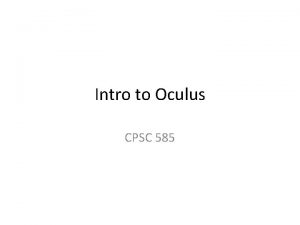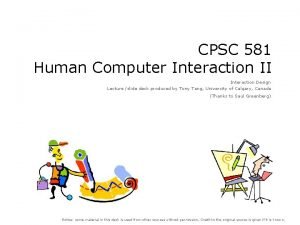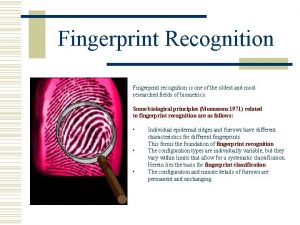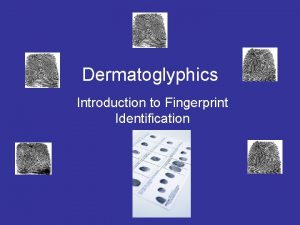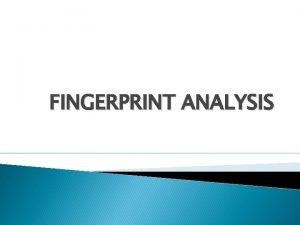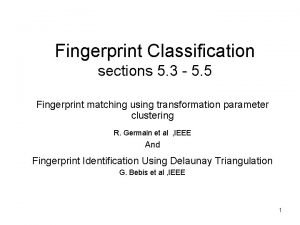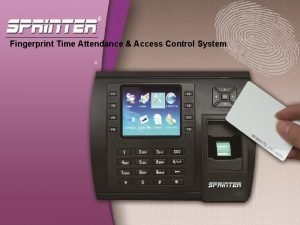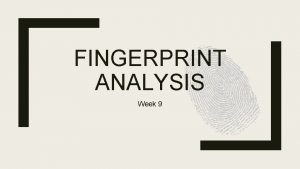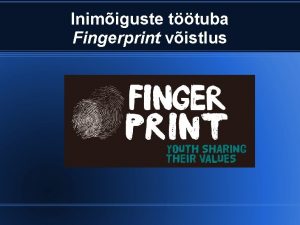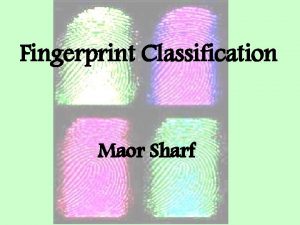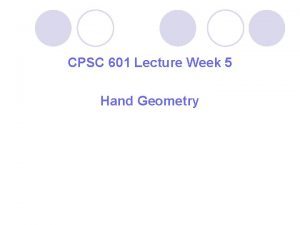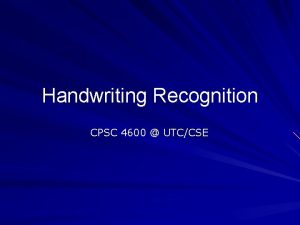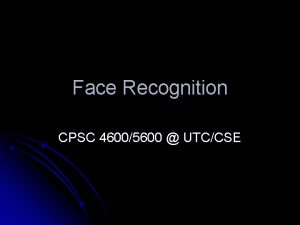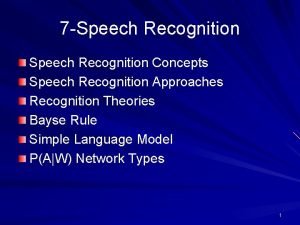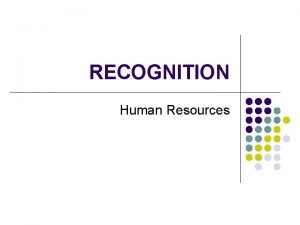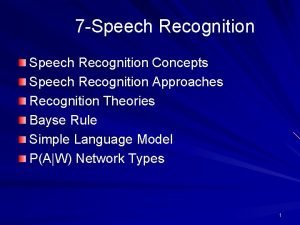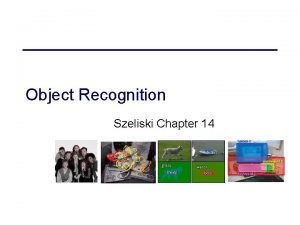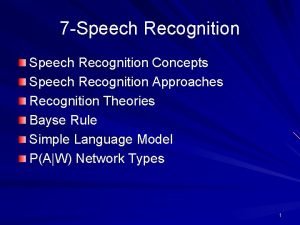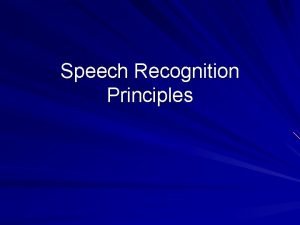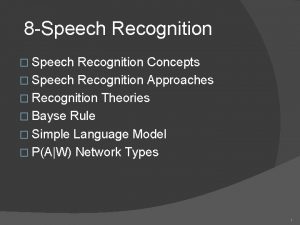Fingerprint Recognition n CPSC 601 1 Lecture Plan
























![Enhancement The variation of the function h in the interval [x 1, x 2] Enhancement The variation of the function h in the interval [x 1, x 2]](https://slidetodoc.com/presentation_image_h/04e3355d6c04c20472ac98d8734dea5d/image-25.jpg)






























- Slides: 55

Fingerprint Recognition n CPSC 601 1

Lecture Plan n n Fingerprint features Fingerprint matching 2

Fingerprint verification and identification 3

Coarse representation –Level 1 features 4

Coarse representation –Level 1 features Left ___ loop ____ Right ____loop ____ Whorl ___ Arch _____ Tented ___ Arch 5

Minutiae –Level 2 features 6

Minutia –Level 2 features 7

Level 3 features Sweat pores 8

Level 3 features 9

Minutiae Detection Original image Binary image Skeleton and extracted minutiae 10

Feature extraction process Fingerprint image Fingerprint area Ridge pattern & Frequency image Minutiae points Orientation image 11

Feature extraction process 12

Orientation image of fingerprint n Computation of gradients over a square-meshed grid of size 16 x 16; the element length is proportional to its reliability. 13

Orientation image of fingerprint 14

n _ _ Frequency image Ridge frequency: inverse of the average distance _ between 2 consecutive peaks _ _ _ _ n _ 15

Segmentation n Segmentation is the process of isolating foreground from background: n n Image block (16 x 16 pixels) decomposition Thresholding using variance of gradient for each block 16

Why do we need enhancement? 17

Why do we need enhancement? 18

Need for Enhancement 19

Enhancement n n Initial enhancement may involve the normalization of the inherent intensity variation in a digitized fingerprint caused either by the inking or the live-scan device. One such process - local area contrast enhancement (LACE) is useful to provide such normalization through the scaling of local neighborhood pixels in relation to a calculated global mean. (a) An inked fingerprint image (b) The results of the LACE algorithm on (a) Histograms of fingerprint images in (a) and (b) above. 20

Enhancement Another type of enhancement is contextual filtering that: 1. Provide a low-pass (averaging) effect along the ridge direction with the aim of linking small gaps and filling impurities due to pores or noise. 2. Perform a bandpass (differentiating) effect in a direction orthogonal to the ridges to increase the discrimination between ridges and valleys and to separate parallel linked ridges. 3. Gabor filters have both frequency-selective and orientation-selective properties and have optimal joint resolution in both spatial and frequency domains. 21

Enhancement Graphical representation (lateral and top view) of the Gabor filter defined by the parameters θ = 1350, f = 1/5, σx = σy = 3 22

Enhancement n The simplest and most natural approach for extracting the local ridge orientation field image, D, containing elements θij, in a fingerprint image is based on the computation of gradients in the fingerprint image. 23

Enhancement n n n The local ridge frequency (or density) fxy at point [x, y] is the inverse of the number of ridges per unit length along a hypothetical segment centered at [x, y] and orthogonal to the local ridge orientation θxy. A frequency image F, analogous to the orientation image D, is defined if the frequency is estimated at discrete positions and arranged into a matrix. The local ridge frequency varies across different fingers and regions. The ridge pattern can be locally modeled as a sinusoidalshaped surface and the variation theorem can be 24 exploited to estimate the unknown frequency.
![Enhancement The variation of the function h in the interval x 1 x 2 Enhancement The variation of the function h in the interval [x 1, x 2]](https://slidetodoc.com/presentation_image_h/04e3355d6c04c20472ac98d8734dea5d/image-25.jpg)
Enhancement The variation of the function h in the interval [x 1, x 2] is the sum of the amplitudes α 1, α 2, … α 8. If the function is periodic or the function amplitude does not change significantly within the interval of interest, the average amplitude αm can be used to approximate the individual α. Then the variation can be expressed as 2α m multiplied by the number of periods of the function over the interval. 25

Gabor filters 26

Enhancement Results 27

Artifacts 28

Post-processing 29

Extraction of minutiae n n count number of ridge _____the ______ __ pixels in the window except middle ______ __ ______ 30

Feature extraction errors n n The feature extraction algorithms are imperfect and often introduce measurement errors Errors may be made during any of the feature extraction stages, e. g. , estimation of orientation and frequency images, detection of the number, type, and position of the singularities and minutiae, segmentation of the fingerprint area from background, etc. Aggressive enhancement algorithms may introduce inconsistent biases that perturb the location and orientation of the reported minutiae from their gray-scale counterparts In low-quality fingerprint images, the minutiae extraction process may introduce a large number of spurious minutiae and may not be able to detect all the true minutiae 31

Fingerprint Recognition n n Fingerprint features Fingerprint matching 32

Intra-variability n Matching fingerprint images is an extremely difficult problem, mainly due to the large variability in different impressions of the same finger (intra-variability). The main factors are: n n n n Displacement (global translation of the fingerprint area) Rotation Partial overlap Non-linear distortion: n the act of sensing maps the three-dimensional shape of a finger onto the two-dimensional surface of the sensor n skin elasticity Pressure and skin condition Noise: introduced by the fingerprint sensing system Feature extraction errors 33

Matching illustration Examples of mating, non-mating and multiple mating minutiae. 34

Matching illustration An example of matching the search minutiae set in (a) with the file minutiae set in (b) is shown in (c). 35

Difficulty in fingerprint matching n Small overlap n Non-linear distortion n Different skin conditions 36

Finger placement n A finger placement is correct when user: n n Approaches the finger to the sensor through a movement that is orthogonal to the sensor surface Once the finger touches the sensor surface, the user does not apply traction or torsion 37

Non-linear distortion 38

Non-linear distortion n Three distinct regions: n n n A close-contact region (a) where the high pressure and the surface friction do not allow any skin slippage A transitional region (b) where an elastic distortion is produced by skin compression and stretching An external region (c) where the light pressure allows the finger skin to be dragged by the finger movement 39

Fingerprint Matching n n n Minutiae-based matching: finding the alignment between the template and the input minutiae sets that results in the maximum number of minutiae pairings Correlation-based matching: correlation between corresponding pixels is computed for different alignments (e. g. various displacements and rotations) Ridge feature-based matching: comparison in term of features such as local orientation and frequency, ridge shape, texture information, etc. 40

Local minutiae matching 41

Minutiae correspondence 42

Pre-alignment n Absolute pre-alignment n n The most common absolute pre-alignment technique translates and rotates the fingerprint according to the position of the core point and the delta point (if a delta exists) Relative pre-alignment n n n By superimposing the singularities By correlating the orientation images By correlating ridge features (e. g. length and orientation of the ridges) 43

Fingerprint matching with absolute pre-alignment n First align the fingerprints using the global structure. n n Input image Template image Extract the core-points (prominent symmetry points) to estimate the transformation parameters v, ϕ (v from the difference in their position, and ϕ from the difference in their angle) by complex filtering of the smoothed orientation field. Then use the local structure for ”point-to-point” matching. 44

Minutiae matching with relative pre-alignment Pre-alignment based on the minutiae marked with circles and the associated ridges Matching results, where paired minutiae are connected by green lines 45

Triangular matching 46

Ridge count 47

DT method n We first compute the Delaunay triangulation of minutiae sets Q and P. Second, we use triangle edge as comparing index. To compare two edges, Length, θ 1 , θ 2 , Ridgecount values are used, all of which invariant of the translation and rotation.

Matching parameters

Correlation based matching n n n Non-linear distortion makes fingerprint impressions significantly different in terms of global structure; two global fingerprint patterns cannot be reliably correlated Due to the cyclic nature of fingerprint patterns, if two corresponding portions of the same fingerprint are slightly misaligned, the correlation value falls sharply A direct application of 2 D correlation is computationally very expensive 50

Example of correlation-based matching From: Correlation-Based Fingerprint Matching with Orientation Field Alignment Almudena Lindoso, Luis Entrena, Judith Liu-Jimenez, and Enrique San Millan

Ridge feature-based matching n Most frequently used features for fingerprint matching: n n Orientation image Singular points (loop and delta) Ridge line flow Gabor filter responses 52

Comparison of Biometric Technologies 53

Fingerprint Recognition n Strengths n n It is a mature and proven core technology, capable of high levels of accuracy It can be deployed in a range of environments It employs ergonomic, easy -to-use devices The ability to enroll multiple fingers can increase system accuracy and flexibility n Weaknesses n n n Most devices are unable to enroll some small percentage of users Performance can deteriorate over time It is associated with forensic applications 54

References and Links n n Signal Processing Institute, Swiss Federal Institute of Technology http: //scgwww. epfl. ch/ Biometric Systems Lab, University of Bologna http: //bias. csr. unibo. it/research/biolab/ 55
 Fingerprint recognition using matlab project
Fingerprint recognition using matlab project Handbook of fingerprint recognition
Handbook of fingerprint recognition 01:640:244 lecture notes - lecture 15: plat, idah, farad
01:640:244 lecture notes - lecture 15: plat, idah, farad Jaynell pittman
Jaynell pittman Ek601
Ek601 Ntp 601
Ntp 601 Mgt 601
Mgt 601 Http 601
Http 601 Nr 601 week 7 reflection post
Nr 601 week 7 reflection post Backpropagation logistic regression
Backpropagation logistic regression 601(b)(10)
601(b)(10) Pgc 601
Pgc 601 Mgt 601
Mgt 601 Pgc 601
Pgc 601 601 pro
601 pro Pgc 601
Pgc 601 Usine peugeot
Usine peugeot Itcp in mobile computing
Itcp in mobile computing Hino 601
Hino 601 601(b)(10)
601(b)(10) Werribee italian social club
Werribee italian social club The size of sme is assessed through: mgt601
The size of sme is assessed through: mgt601 Pgc world
Pgc world Linear regression loss function
Linear regression loss function An opportunity assessment plan
An opportunity assessment plan Ubc cpsc 404
Ubc cpsc 404 Cpsc 329 uofc
Cpsc 329 uofc Cpsc 441
Cpsc 441 Cpsc 329
Cpsc 329 Cpsc 314 ubc
Cpsc 314 ubc Cpsc 314
Cpsc 314 Cpsc 111
Cpsc 111 Cpsc 449
Cpsc 449 Cpsc 321
Cpsc 321 Cpsc 219
Cpsc 219 Cpsc 422
Cpsc 422 Cpsc 581
Cpsc 581 Cpsc 581
Cpsc 581 Cpsc457
Cpsc457 Cpsc 433
Cpsc 433 Cpsc 335
Cpsc 335 Cpsc 335
Cpsc 335 Mycin
Mycin Cpsc 319
Cpsc 319 Cpsc 319 u of c
Cpsc 319 u of c Geoffrey tien ubc
Geoffrey tien ubc Cpsc 233
Cpsc 233 Cinda heeren
Cinda heeren Cpsc 121
Cpsc 121 Ubc cpsc 314
Ubc cpsc 314 Cpsc314
Cpsc314 Cpsc 314
Cpsc 314 Cpsc 386
Cpsc 386 Cpsc 441 assignment 1
Cpsc 441 assignment 1 Cpsc 585
Cpsc 585 Cpsc 581
Cpsc 581

